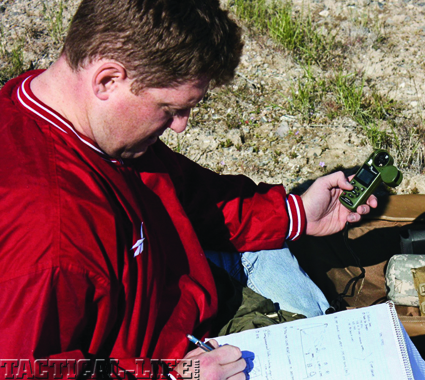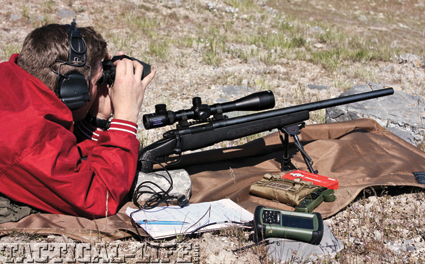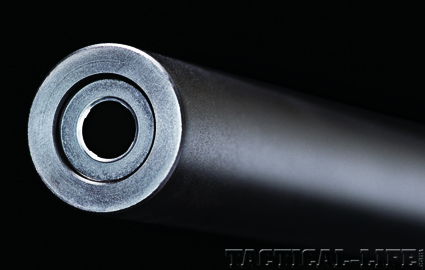The System: The integration of weather, range, ballistics, optics and a precision firing platform. Clockwise from right: The FN SPR-A1 with Horus Falcon 5-20×50 scope with an H25 reticle, the Vectronix LRF, Horus ATragMX ballistics computer and the Kestrel 4500 pocket weather meter. The author ranges the target with the Vectronix LRF attached via cable to the ATragMX Ballistics Computer.
For precision shooters, the operational challenge of getting a safe and accurate first-round shot grows increasingly complex as defense and law enforcement units are tasked with both expanded missions and an increased sensitivity towards liability. For snipers, success requires more than what one Army instructor referred to as “lying on your stomach and making an accurate shot.” Distances to multiple targets, shot angle—particularly in urban environments—as well as environmental factors all combine to impact ballistic performance and optics adjustment. TW combined the FN SPR rifle and Horus/Vectronix SORD ballistics and ranging system to test two of the industry’s newest precision shooting tools and learn if the combination was greater than the sum of its parts.
Special Police Rifle
FNH USA’s SPR (Special Police Rifle) series was designed with simplicity and reliability in mind. The SPR was awarded an FBI HRT (Hostage Rescue Team) contract in 2004, and according to FN, “The SPR A3 was selected after a 10,000-round endurance test with two rifles resulting in no parts breakage, misfires or malfunctions while exceeding the accuracy requirement of .50 MOA.” TW evaluated the SPR A1 for this article.
Advertisement — Continue Reading Below
The SPR’s pre-’64 Winchester action features a claw extractor and the traditional CRF (controlled round feed) mechanics. While volumes have been written in the debate between CRF and “push feed actions,” the Mauser-inspired claw does reliably control the round via contact with the rim throughout the cycle (as opposed to the push feed which engages the rim only when the bolt handle is turned down and fully locked).
This positive contact eliminates the risk of a mis-feed if the rifle is inverted or on its side. Additionally, the claw extractor allows the modern shooter to control the force with which the round is ejected. Should the shooter find himself in an operational circumstance where brass casings cannot be left on site, a slow cycle of the bolt will lightly drop the casing in his hand. Mechanics, not force, controls the action and the management of the action and the casing.
The SPR also features a three-position safety that functions (from right): safety on, bolt locked, (middle) safety on, bolt can be opened for reloading, (left) ready to fire.
Advertisement — Continue Reading Below
SPR barrels are cold hammer-forged to Mil-Spec with hard-chromed bores, target crowns, and are held to +/- .001-inch headspace, advertised to produce and maintain 1 MOA accuracy. Each barrel also comes with a factory installed MIL-STD 1913 rail with an additional 20 MOA of elevation. Originally fitted with aluminum stocks, the SPR now comes fitted into a matte black McMillan fiberglass stock with three sling-mounting points and a textured close-radius vertical grip. The SPR can be ordered with a hinged floor plate or detachable box magazine.
Advertisement — Continue Reading Below
The SPR lines now includes four models: the A1, the A1A (identical to A1 but with a 20-inch barrel), the A3G—hand bedded with Marine-Tex into a fully adjustable McMillan A3 fiberglass stock (advertised to have .50 MOA accuracy at 100 yards) and the A5 M—chambered in a .300 WSM with a 24-inch fluted barrel and McMillan A5 stock. The version ordered by the FBI HRT—the SPR-A3G‚—features special modifications that include a 24-inch fluted barrel, steel floor plate, five-round capacity magazine, and specialized FN OP2 titanium scope mount and rings.
The Horus/Vectronix SORD System
Horus and Vectronix teamed up to provide an integrated solution for fast and accurate aiming solutions. In the words of long range shooting instructor, Todd Hodnett, “We started with a vision of combining a shooting solver and a range finder into a HUD (heads-up display) for the shooter.” In its current version the system has three elements:
➊ATragMX ballistics calculator
➋Vectronix laser rangefinder
➌ Kestrel 4500 pocket weather meter
Advertisement — Continue Reading Below
The brains of the operation is the Horus ATragMX ballistics calculator. The ATragMX software comes loaded into an SD chip where it can be operated in most Pocket PCs. The SORD system utilizes a ruggedized TDS (Tripod Data Systems) Recon unit that can be run from AA batteries, charged via vehicle cigarette lighter sockets or connected directly to a vehicle’s battery using a 12V adapter.
ATragMX is an advanced ballistics calculation software that formats shooting solution data inputs and outputs into a simple and intuitive table. Data is input either manually using scrolling buttons on the Recon unit or a stylus pen, thus allowing use with gloves and in cold weather environments. Like most ballistics calculators, the ATragMX begins with gun/projectile information that can be customized to individual shooters, weapons and loads. Once the load and weapon information is loaded and chosen by the user, ATragMX takes over and accounts for external variables. In addition to range and velocity calculations, ATragMX accounts for wind speed/direction, Coriolis effect, and spin drift in its solutions. With a Kestrel 4500 pocket weather tracker, operators can, in one unit, gauge wind speed/direction, cross/tail/head wind, barometric pressure, altitude, and humidity. These data points can then be input into the ATragMX system to further refine the shooting solution. Upcoming models will have a Bluetooth connection between the two units where users simply take a weather reading and send the data to the Recon unit.
The LRF is a rangefinder with a brain that is directly connected via a wireless or serial cable to the ATragMX system. The Vectronix LRF can range targets out to 3,000 meters in up to eight zones. In addition to long-distance ranging, the LRF has advanced north- finding technology as well as an accelerometer that measures angle. This technological leap forward in hand-held technology allows the shooter to measure not only distance but also angle. The resultant data goes directly to the ATragMX and adjusts the shooting solution appropriately.
Advertisement — Continue Reading Below
Operationally, the shooter need only attach the two devices together (the ATragMX/Recon unit and the Vectronix LRF), range the target with the LRF to gather the distance and angle data, apply the appropriate “gun” info in the ATragMX, and the solution is instantly displayed in milliradians or MOA adjustments in both standard and metric distances.
The Horus Reticle
Mounted on the SPR was a Horus Vision Falcon 5-20×50 illuminated scope with the Horus H-25 reticle. Dennis Sammut, President of Horus describes the Horus reticle as: “a mil-dot reticle we sent to college.” Rather than graduated circles or ovals along the crosshairs, the H-25 has a precisely marked grid system in the lower half of the reticle that reflects milliradian adjustments in the first focal plane. In the event the shot misses, the shooter must only note the bullet’s impact location on the reticle grid, and use that intersection point as the new point of aim. In theory, a first shot miss can be precisely corrected (presuming the round impact is visible) without ever manipulating the optics.
I was skeptical. Having spoken with two S.W.A.T. snipers about the reticle, one liked it but stuck with his familiar MIL DOT and the other found the reticle too cluttered.
Range Results
One of the perks of living in the beautiful state of Utah is the utter vastness of the land and various terrain that would make most long-range shooter’s eyes water at the potential. The first phase started with a new rifle, a freshly mounted scope, and an unfamiliar ballistics and ranging system. My practice beforehand consisted of zeroing the rifle at the local Lion’s Club range and ranging my neighbor’s cars and mailboxes with the Vectronix LRF and calculating solutions in the ATragMX.
Advertisement — Continue Reading Below
Phase II involved a move to a remote ridgeline west of the Great Salt Lake. Using Black Hills 175-grain Sierra Match King OTM boat-tails, the rifle shot sub-MOA groups at 100 and 200 yards. I was still technically within the break-in period on the rifle so I took it slow and kept the rifle clean. After about 60 rounds within 200 yards, curiosity got the better of me. I set up a white MGM silhouette target at 900 yards and painted a 2-inch black dot at center mass. Matt Winslow, a USMC DM acted as my spotter and we ranged the target to confirm the distance. There was little wind but the heat mirage was building up. Winslow gave me the adjustment, I placed the corresponding grid intersection on the dot and broke the shot. After hearing the distinctive impact gong from the steel target, I looked over to see Winslow smiling from ear to ear behind the Leupold spotting scope.
“Dude, you hit dead center of the dot.” he said with excitement.
“Well, I guess the scope’s not broken,” I replied in dry fashion.
Advertisement — Continue Reading Below
The first round placement proved to be fortuitous, but nonetheless exciting. I put 10 more rounds within a 5.5-inch group around the center of the dot.
I returned to our favorite spot for Phase III. My brother Charles, an Army Combat Engineer officer just returned from Afghanistan, was my spotter. Charles said the bugs were the same as Afghanistan, but Utah smells a lot better.
We set up multiple targets at 100 yards, confirmed zero, and shots groups with four separate loads. The SPR was performing well with all the rounds but seemed to like the Black Hills 175-grain Sierras best, so we climbed a steep cliff that edged the desert valley on our makeshift range.
Advertisement — Continue Reading Below
Charles had set out a converted real estate sign painted white with an eight-inch black circle at a medium distance and the steel MGM silhouette target at a longer range. After a humbling hike/climb up the steep cliff, we were now 185 feet above our targets on the valley floor. We set up, took a weather reading on the Kestrel unit and ranged the target. The nearer target was 550 yards and the distant steel target was at 1,055 yards.

Collecting weather data including altitude, barometric pressure, wind speed and direction using the Kestrel 4500.
The ATagMX gave us an elevation solution of 3.62 mils. This accounted for distance and the off angle created by our elevation (roughly 7 degrees). My first, second and third shots did not impact the target. I looked to Charles, “I think you are shooting just under it.” I made a .4 mil adjustment in the reticle and put the next nine rounds in the circle. So in this scenario, the grid adjustment concept worked, we aimed according to the shooting solution data and corrected visually without touching the turrets.
Now for the long-distance challenge: The 1,055-yard solution was an elevation correction of 11 mils. While nearly twice the distance, the off-angle was slightly less than half of the previous target so I was curious to see how accurately the ATragMX adjusted. To my surprise, the first round—and the next 10 rounds—landed within a 9.5-inch group on the steel target. Not too shabby for a gun writer. Within scenarios I could create and using the variables I could induce, this system works.
Parting Shots
Out of the box, the SPR rifle is an accurate and consistent performer. There are no fancy gimmicks to this rifle. It handled multiple loads, well within its stated 1 MOA accuracy guarantee. The SPR has a strong, well-fitted action, crisp trigger and high quality barrel. At the end of the test I wished FN would have sent the A3 so I could have tested that model’s bold .50 MOA guarantee, but the ultimate data might have been limited by my shooting skills. The McMillan stock is an appropriate complement, but it would have been nice to have the option to adjust the comb and pull. At more than 12 pounds loaded, the rifle is not light nor do I suspect it is intended to be, but it was noticeable carrying it up a cliff at more than 4,000 feet. Paired with a quality optic, the SPR is a precise platform.
The SORD system is a unique collection of technology, and it works. This integrated system quickly and accurately takes the guesswork out of distance, angle, and ballistics. In our modern age, accurate shooting solutions can save lives, and limit liability. With such coordinated devices, the increased speed equals greater proficiency.

























